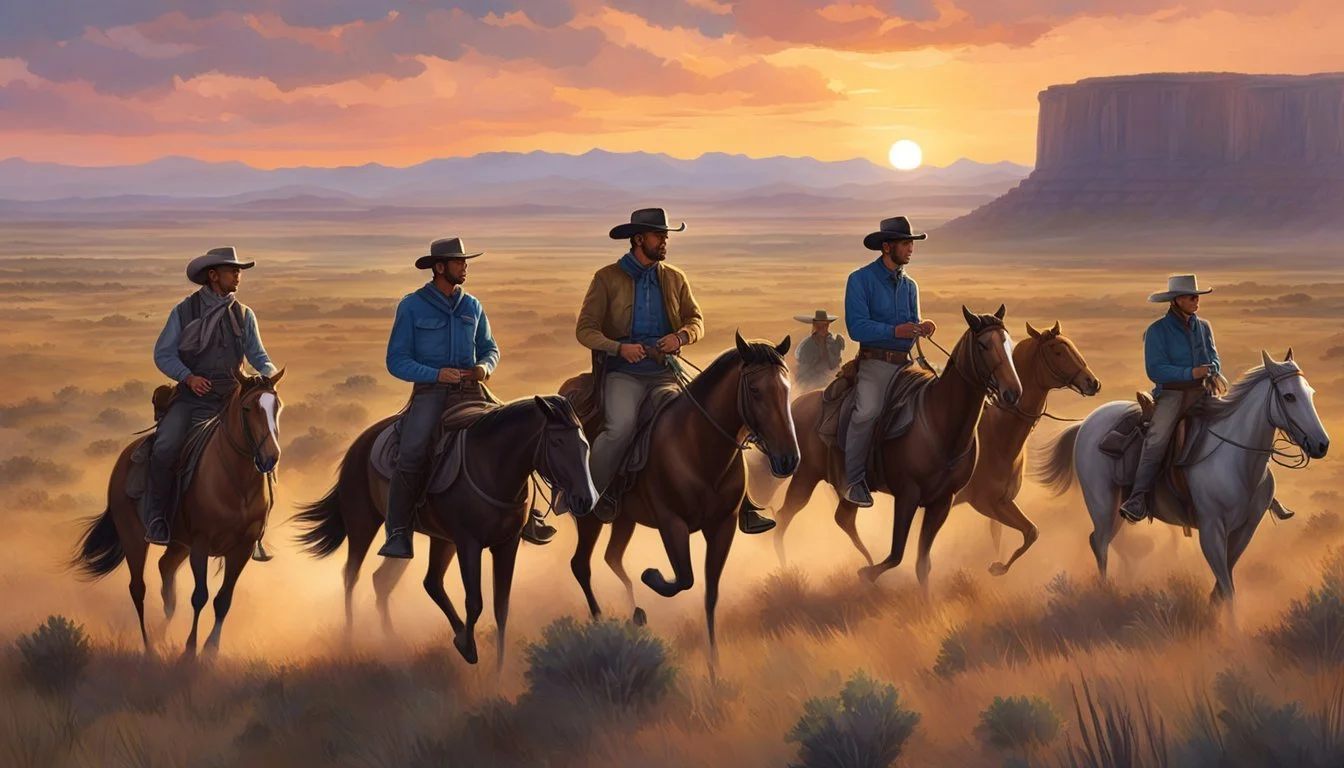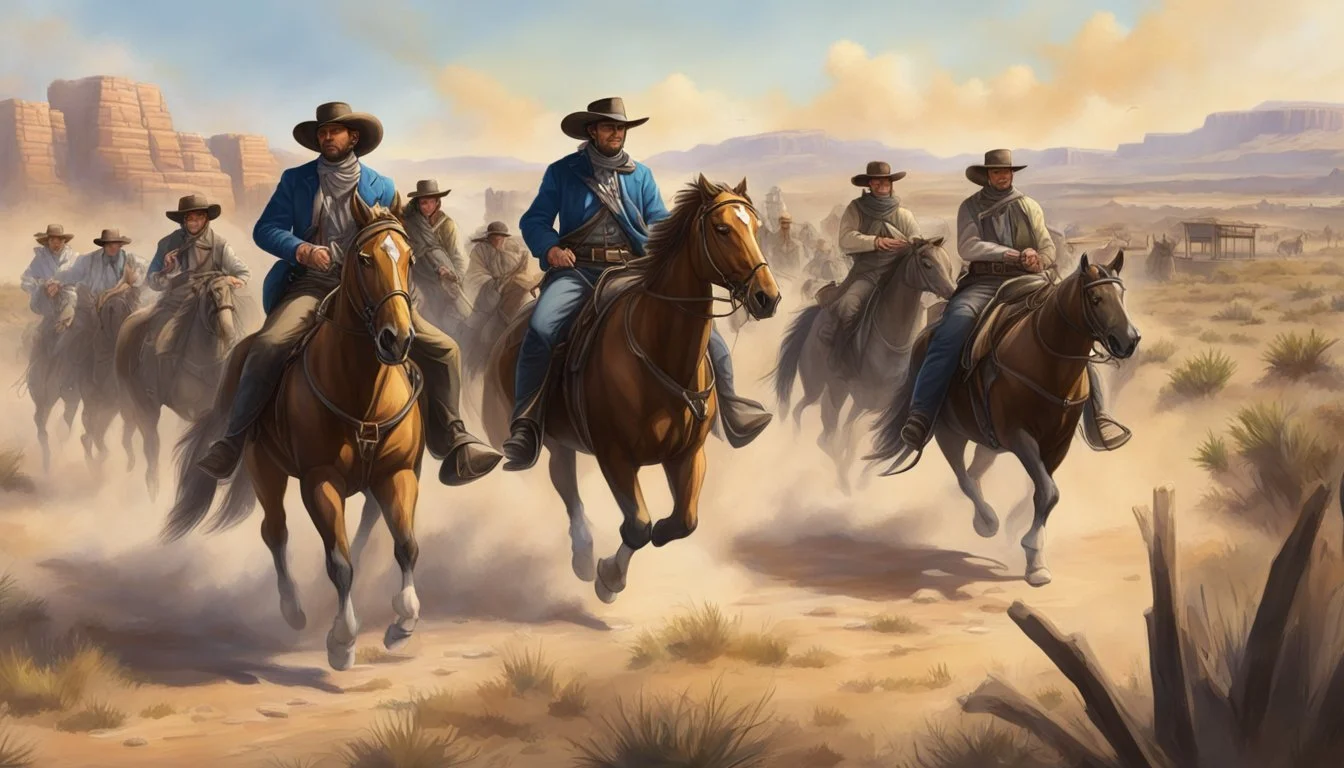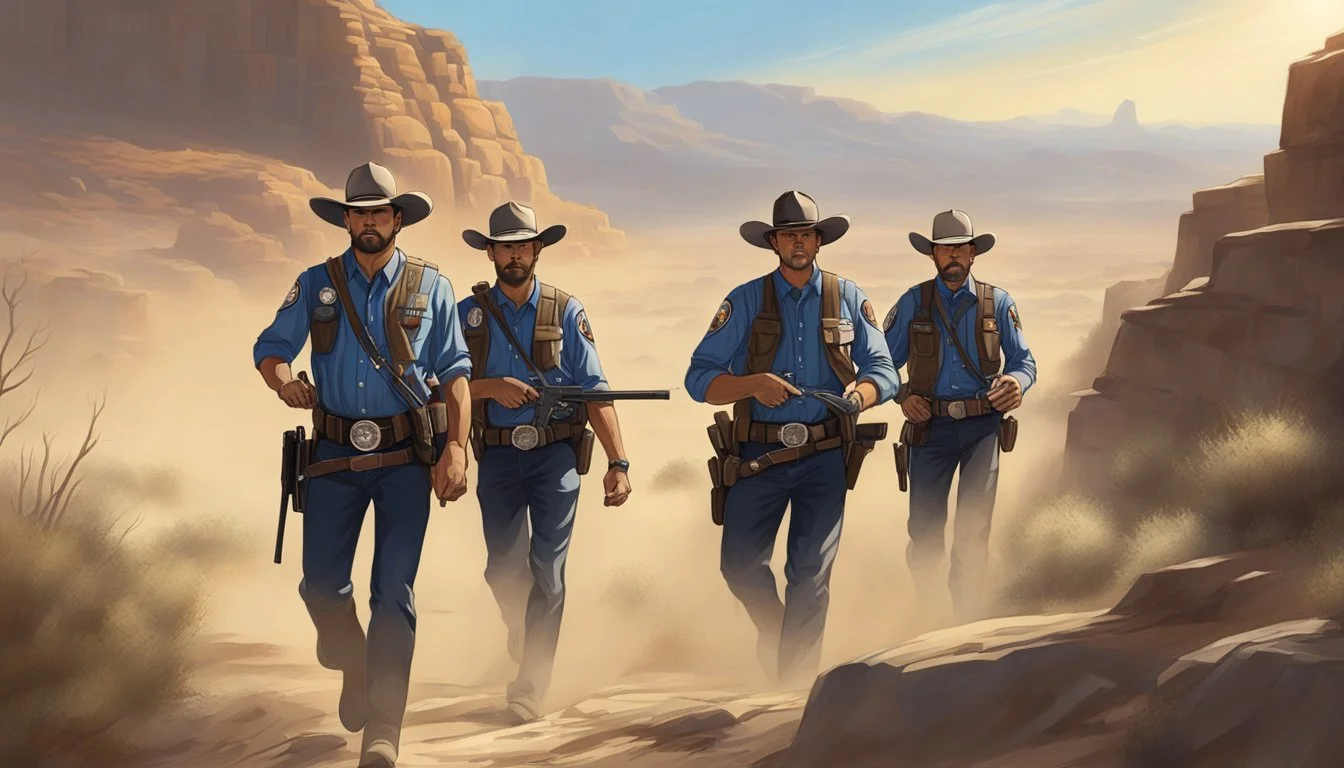The Texas Rangers
Lawmen of the Cowboy Era - Upholding Justice in the Wild West
The Texas Rangers hold a legendary place in the annals of law enforcement, tracing their origins to the early days of Texan settlement. Formed to protect settlers on the nascent frontier, the Rangers evolved from a loose group of frontiersmen in the early 19th century into a formalized law enforcement body. As one of the oldest law enforcement organizations in North America, they played a pivotal role in maintaining order during the tumultuous period of westward expansion.
Over the years, the Rangers adapted to the changing dynamics of Texas, providing a response to the diverse challenges of enforcing laws on the vast frontier. They confronted a myriad of duties, from investigating crimes to apprehending criminals, and became emblematic of the "cowboy lawmen" of the era. Their history, steeped in tales of bravery and jurisdictional authority, includes moments of controversy, reflecting the complex nature of frontier justice.
As storied as their past, the Texas Rangers' influence extended beyond the confines of historic skirmishes and criminal pursuits. Their legacy is a tapestry reflecting the evolving social, political, and legal framework of Texas. Despite their historical complexities, the Texas Rangers are a symbol of the enduring quest to establish and maintain law and order on the frontier, their reputation cemented within the larger story of the state's storied past.
Historical Formation and Evolution
The Texas Rangers have a rich heritage that began with their formation in the early 19th century and evolved through significant historical periods including the Texas Revolution, statehood, and modernization of law enforcement practices.
Early Beginnings and Stephen F. Austin's Influence
Stephen F. Austin, often considered the "Father of Texas," established a group of rangers in 1823 to protect settlers in the then-Mexican territory. This paramilitary force was responsible for providing safety in the face of external threats, primarily from hostile Native American tribes.
The Texas Revolution and Independence
During the Texas Revolution (1835-1836), the Rangers played a pivotal role as a scouting and fighting force, contributing significantly to the eventual independence of Texas. Their skills in reconnaissance and guerrilla tactics were instrumental during key battles against the Mexican army.
From Republic to Statehood: The Frontier Battalion
After Texas gained independence and became a Republic in 1836, the Rangers' role transformed to include law enforcement. The creation of the Frontier Battalion in 1874 reinforced their task to defend frontier settlements. The Rangers became essential in controlling lawlessness and were often viewed as the iconic "cowboy lawmen" of the era.
Civil War and Reconstruction Era
The Rangers' activities were disrupted during the Civil War as Texas seceded from the Union. Post-war, during Reconstruction, their numbers dwindled, but they were eventually reformed to help maintain public order, despite facing criticism for methods that could be harsh or extrajudicial.
Transition to Modern Law Enforcement
In 1935, the Texas Legislature established the Texas Department of Public Safety, integrating the Texas Rangers and the Texas Highway Patrol into one agency with statewide jurisdiction. The Rangers transitioned into a modern law enforcement body equipped to handle a diverse range of criminal investigations and law enforcement duties.
Structural and Jurisdictional Overview
The Texas Rangers operate as a critical link in the law enforcement chain within the state of Texas, renowned for their historical significance and present-day jurisdictional reach.
Ranger Divisions and Companies
The Texas Ranger Division is organized into several companies, each designated with a letter from "A" through "F". Company "A" through Company "F" cover specific geographic zones in Texas, ensuring state-wide coverage and allowing for a specialized response to incidents within localized areas. Each company is composed of Ranger units led by experienced officers, tasked with a range of investigative duties.
Integration with the Department of Public Safety
In 1935, the Texas Rangers were integrated into the newly formed Texas Department of Public Safety (DPS). As part of the DPS, the Rangers received modernization in both training and equipment, aligning with broader statewide law enforcement objectives. The Rangers have statewide jurisdiction and can act on any criminal matter. The integration into the DPS means that while the Rangers retain a degree of autonomy in their operations, they are also a crucial component of the larger body dedicated to public safety across Texas.
Notable Rangers and Leadership
Throughout their storied history, the Texas Rangers have been shaped by skilled leadership and iconic figures whose reputations often match the enormity of the Texan landscape.
Samuel H. Walker and the Walker Colt
Samuel H. Walker, a notable Texas Ranger captain, made significant contributions to law enforcement weaponry. He collaborated with Samuel Colt to develop the 1847 Colt Walker revolver, a heavyweight weapon that became the 1847 Walker Colt. Its design was based on Walker's experiences, and it proved to be a formidable force in the hands of Rangers.
Captain Bill McDonald and Frontier Law
Captain Bill McDonald embodied the image of a Ranger during the late 19th century. Known for his strict adherence to law and fearlessness, McDonald led with an intuitive understanding of frontier justice. As a leader, his philosophy of "One Riot, One Ranger" demonstrated confidence in the individual abilities of his men to handle any situation.
Frank Hamer and the Hunt for Bonnie and Clyde
Frank Hamer was a legendary figure in the ranks of the Rangers, renowned for his tenacity and investigative prowess. A former Ranger captain, he was brought out of retirement specifically to track down the infamous criminal duo Bonnie Parker and Clyde Barrow. His leadership and investigative skills culminated in the 1934 ambush that ended the pair's crime spree.
Rangers in Conflict and Consort
The Texas Rangers were pivotal during periods of conflict in the Texan frontier, dealing with threats from the Comanche during Indian wars, playing roles in conflicts with Mexico, and curbing outlaw activities in the region.
Indian Wars and the Comanche Threat
The Texas Rangers' history is marked by their significant presence during the Indian Wars, particularly in skirmishes against the Comanche. They were integral in protecting settlers by responding to raids and were often engaged in aggressive campaigns to push back or displace indigenous tribes from lands coveted by European-American settlers.
The Role in the Mexican War and Revolution
During the Mexican-American War (1846-1848), Rangers served as scouts and fought in several key battles, aiding the United States' victory which led to the annexation of Texas. Later, with the emergence of the Mexican Revolution in 1910, the Texas Rangers reinforced the Rio Grande, defending Texas from revolutionary activities and incursions.
Addressing Outlaws and Bandits
In response to outlaws and bandits, the Rangers operated as a de facto law enforcement agency, tracking down cattle thieves and bank robbers. Their reputation was built on instances of swift and decisive action, which included the use of force, and sometimes resulted in controversial acts that blurred the lines between law enforcement and vigilantism.
Legal Proceedings and Controversial Actions
The Texas Rangers, as lawmen, have faced scrutiny for their legal proceedings and use of force, which have at times led to controversy. This section sheds light on the dichotomy of their role in imposing law and order and the contentious incidents that arose.
Civilian Trials and Ranger Accountability
The Texas Rangers have a complicated history with the legal system, balancing their role as peace officers with the quest for justice. Accounts from the past indicate that during the cowboy lawmen era, Rangers were entrusted with the authority to arrest and sometimes execute justice rapidly, which sometimes bypassed the typical process of civilian trials. While their early actions often lacked formal oversight, legislation in 1901 formally established the Rangers as the Ranger Force, striving for greater accountability within the bounds of the law. However, the absence of a consistent legal framework in the early years sometimes led to Rangers acting as judge, jury, and executioner—a point of historical contention.
Notable Trials Involving Rangers:
Ranger prosecutions for criminal acts, often rare, indicated the complex nature of holding them accountable given their esteemed position.
Instances of legal proceedings involved scrutiny over Rangers' decisions in high-stakes situations, reflecting the tension between frontier justice and legal standards.
Tumultuous Incidents and Use of Force
Notwithstanding their role as defenders, the Rangers have faced allegations of excessive violence. For instance, the intervention of Rangers in re-establishing order often involved substantial use of force, raising questions about the necessity and extent of such actions. Memorable episodes of violence include the 1906 Rio Grande City riot and the controversial 1918 Porvenir Massacre, where the Rangers' involvement in violence against civilians highlighted the darker aspects of their legacy.
Cases of Controversial Use of Force:
Rio Grande City riot (1906): A clash resulted in the death of a Ranger, prompting a forceful response from the unit that led to civilian casualties.
Porvenir Massacre (1918): Rangers were implicated in the killing of 15 Mexican men, igniting a nationwide controversy and creating a lasting impact on the Rangers' image.
Cultural and Societal Impact
The Texas Rangers have exerted a profound influence on popular culture, particularly through literature and film, and have shaped public perception of law enforcement in the American West.
The Rangers in Literature and Film
The image of the Texas Rangers has been immortalized in literature and film for over a century. Texas Rangers in Westerns provided a consistent presence in cinemas since the silent movie era, often portrayed as the archetype of the Western hero. Notably, characters like the Lone Ranger have become cultural icons, embodying the ideals of justice and bravery. A phenomenon began in the silent era with stars such as Tom Mix and Buck Jones portraying Rangers in countless films. The portrayal continued well into the 21st century, solidifying their place as a staple of the Western genre.
1910: First appearances of Texas Rangers in theaters.
21st Century: The legacy continues with frequent representations in media.
Public Perception and the Ranger Legacy
The Texas Rangers helped shape the national image of Texas and the broader narrative of American history. Their history has been marked by acts of bravery and controversy, creating a complex legacy. Though often romanticized as noble lawmen in white hats, the Rangers' story also involves darker moments, including extrajudicial actions. Their role in maintaining order and protecting settlers is a contentious symbol within Texas history, reflecting both heroic and problematic aspects of their influence.
The public perception of the Rangers has been a mixture of admiration and critique, making them a subject of cultural examination and revision. Over time, the Rangers have been scrutinized and reassessed, as newer historical understandings shed light on their actions and place within society.
Operational Tactics and Equipment
The Texas Rangers relied on a variety of equipment and tactics to maintain law and order in the Lone Star State, from the iconic firearms they carried to their methods of scouting and investigation.
Firearms, Horses, and the Ranger Badge
Rifles:
The Rangers favored rifles for their accuracy and long-range capabilities.
Popular models included the Winchester lever-action rifles.
Pistols:
Revolvers were standard issue for close encounters and ease of mobility.
Colt Single Action Army revolvers were widely used.
Ammunition:
Rangers carried a suitable supply of ammunition for their firearms, ensuring readiness for conflict.
Mounts:
Horses were essential for patrolling vast Texan territories and pursuing outlaws.
The Rangers' mounts were fast and sturdy, enabling them to traverse diverse terrains.
The Ranger Badge:
The badge, shaped like a five-pointed star within a wheel, was made from a Mexican five peso coin.
It was a recognizable symbol of authority and commitment to justice.
Scouting, Surveillance, and Investigative Methods
Scouting:
Rangers often conducted scouting missions to track outlaws and assess threats.
Ambushes and raids were planned based on the intelligence gathered from these missions.
Surveillance:
Covert surveillance was a key tactic in gathering information without revealing the Rangers' presence.
This method often involved monitoring suspect activities over extended periods.
Investigative Methods:
Rangers combined traditional detective work with their intimate knowledge of the terrain and local populations.
Interrogation and informants played a significant role in piecing together evidence for convictions.







